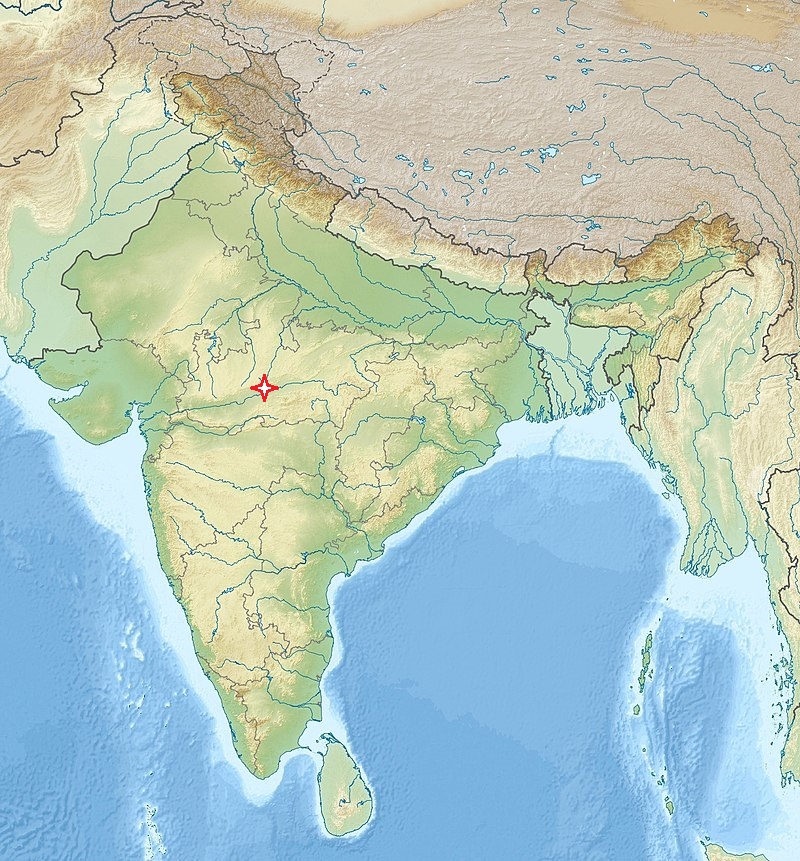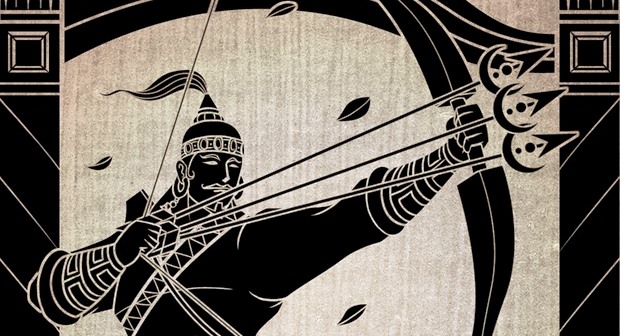Indian Archery
Indian Archery – From Past to Present
It is well known that India has a long and fascinating history, stretching far back into ancient times. Having such a lengthy history, India maintains an intimate relationship with an ancient practice: archery. From the Vedic era, which began approximately 1500 years BCE, to the relatively recent Olympic games of the 21st century AD, the subcontinent and its people have not forgotten the ancient art. Let us explore Indian archery, from the remote past to the present age.

Indian Archery History
Indian archery was held in extremely high regard by the ancient Indians. The practice, for the most part, can be traced back to the Vedic period (c. 1500 – c. 500 BCE), yet archery was likely known and practiced much earlier. In fact, very recent discoveries (2020) have found evidence for archery equipment (arrowheads) in a cave in Sri Lanka. These artifacts were dated to be approximately 48,000 years old! This find is in fact the oldest evidence for archery outside of Africa that we know of currently. The following section gives some insights into archery in ancient India, and how we know it was practiced far into the distant past.
Ancient Indian Archery
Early evidence of Indian archery can be derived from two main sources; ancient cave paintings and ancient texts, namely the Vedas. The Vedic sagas are some of the oldest sacred texts we know of and are estimated to be compiled c. 1700–1100 BC. The Vedic sagas had been transmitted orally for millennia before the great effort was undertaken to write down the information. We will discuss Indian archery in the Vedas in a later section, but for now, let us consider even older and equally interesting evidence for archery in India. These would be paintings in caves in central India; the Bhimbetka rock shelters.
Bhimbetka Rock shelters
The Bhimbetka rock shelters are a group of caves in central India which were inhabited by prehistoric humans for many thousands of years. Some of the caves contain a treasure trove of artifacts and cave paintings which gives us a rare insight into the lives of these prehistoric hunter-gatherers in the area.

The caves in the area number about 750, although only 15 are open to the public a present. The caves contain several paintings on the walls which are considered some of the oldest petroglyphs in the world. The oldest of these have been found to be 10,000 years old, and some are relatively new additions from the medieval period.
The paintings depict scenes from everyday life, which is helpful in giving us insight into what these people were doing back then. Relating to our topic of archery, many paintings clearly depict large numbers of archers! The bows and arrows are carefully depicted in the hands of these ancient archers. The scenes usually depict the hunting of large herd animals, yet some human on human conflicts with bows are also represented. From these finds in the caves in the center of India, it would be safe to infer that Indian archery was practiced for a very long time indeed.

Sindhu Sarasvati & Vedic Culture Archeological Finds
The Sindhu Sarasvati or Saraswati civilization left us with a plethora of archeological artifacts, some from 7000 BCE all the way up to 300 BCE. The Sindhu Sarasvati civilization was part of the ancient civilizations in the Indus valley in what is today north-western India and Pakistan. They flourished during the bronze age and several bronze arrowheads have been recovered from several sites, including Mohenjo-Daro.

The Indus-Valley civilization was a contemporary of the other major ancient civilizations, notably those of Mesopotamia (Sumeria) and ancient Egypt. The Indus-Valley people traded and interacted with many peoples, and it flourished. By 2500 BCE the region became the largest, if not the greatest civilization of the Ancient world. Its region of influence expanded over one million square kilometers at its height, with an estimated population of five million people.

Indian Archery & Vedic Literature
Indian archery is well represented in one of the most colossal and ancient texts ever written. These are of course the Vedas. The Vedas are a collection of religious texts written down sometime between c. 1500 – c. 500 BCE (the Vedic Period). The Vedas were written in Sanskrit and were the basis of early Hinduism.
Long before the Vedas were committed to being written down, they were an oral tradition going back serval thousands of years. It is widely believed that they originated as far back as the sixth or fifth millennia BCE. Because of their original oral tradition, the Vedas are regarded as Shruti in Hinduism which means “what is heard” as compared with other works designated Smritis (“what is remembered”)

The term Veda ( वेदः ) literally means knowledge in Sanskrit, and packed full of knowledge these texts are! A recent (2015) edition of the four books of the Vedas consists of 4044 pages!
As mentioned the Vedas can be divided into four main books:
- Rig Veda (Rigveda)
- Sama Veda (Samaveda)
- Yajur Veda (Yajurveda)
- Atharva Veda (Atharvaveda)
Within these four main divisions of the texts, a further subdivision into four types of writing and subject matter follows:
- Aranyakas – rituals, observances
- Brahmanas – commentaries on said rituals
- Samhitas – benedictions, prayers, mantras
- Upanishads – philosophical narratives and dialogues
The authorship of the Vedas is unknown, as it has been lost to time. It is believed Rishis or Sages of bygone eras, being divinely inspired, created them.
Within the Vedic text Yajurveda (1100 – 800 BCE) there is an especially noteworthy section. It is a treatise on warfare and archery known as Dhanurveda. It considers all aspects of archery, and one could infer the importance placed on the practice with its inclusion in the Vedic texts.
Dhanurveda
Dhanurveda is a section of Vedic texts relating to archery (dhanus “bow” and Veda “knowledge”). It is contained within the second text, Yajurveda. Several hymns in the Rigveda and Atharvaveda also emphasize the use of the bow and arrow.
Archery was emphasized as an especially vital martial skill for the warrior classes as well as royalty. The text is thorough and covers the practices and uses of archery, bow and arrow construction, military training, and rules of engagement.
Much like Japanese traditional archery or kyudo, Dhanurveda places special emphasis on the spiritual nature of archery. The meditative and silent mental state which is ideal for consistency and accuracy of shots is held in high regard by the author(s) of Dhanurveda.
Indian Archery, Myth & Heroes
There are very many heroes in ancient Indian mythology who were renowned for their skill with the bow and arrow. Please check out our blog article titled: “Famous Archers in Mythology, Fiction and History” for a comprehensive list and background on many famous archers, including ones from Indian mythology.
Some of the popular and well-known archers from Indian mythology include:
Arjuna
Arjuna was is the chief protagonist of the Indian epic Mahabharata. The Mahabharata is one of the two major Sanskrit epics of ancient India, the other being the Rāmāyaṇa. The Mahabharata is truly epic in scope. Considered to be the longest poem ever written, at about 1.8 million words in total. The Mahābhārata is roughly ten times the length of the Iliad and the Odyssey combined. The epic likely reached its full compilation in the 4th century B.C. After learning weaponry from Drona, Arjuna becomes a very skilled archer, able to “hit the eye of a bird” in a tree. In art, he is very often depicted with a bow and arrow.

Bhishma
Bhishma is another prominent figure in the Mahabharata. He is the son of the Kuru King Shantanu and the river goddess Ganga. He was one of the best archers and warriors of his time and he was trained by Lord Vishnuś sixth avatar Parshuram.
Arjuna and Bhishma fight in the Kurukshetra War which is the main conflict the Mahabharata centers on. Bhisma is brought down by Arjuna who had pierced his back with innumerable arrows. The arrows were so many that as Bhishma collapsed on his back he lay suspended on a bed of arrows that stuck out of his backside.
Drona
Another epic character from the Mahabharata. He was a master of advanced military arts, including the divine weapons or Astras. Drona was also a master archer.
The Mughals & Indian Archery
For much of the medieval period in India, the continent had seen a seemingly unending power struggle between various factions. With the rise of Islam in the 7th century, A.D. came increasing raids from the West, and the establishment of the Delhi Sultanate in the north of India in the 13th century A.D. The rise of the Mongols was also a cause for concern, as they had conquered most of the territories to the north of the subcontinent.
All this changed when the Mughals entered the scene, conquering and subduing most of the continent and enacting various reforms which ultimately led to some unification and stability.
The conventional founder of the empire is known by the name of Babur. He hailed from the lands to the West of India known as the Timurid empire after its founder Timur, or Tamerlane. These lands encompass much of modern-day Afghanistan, Pakistan, Eastern Iran, Turkestan, and Azerbaijan, and Kazakhistan. The Timurids designated themselves as “Gurkani”. This word, being a derivative of “Gurkan”, a Persianized form of the Mongolian word “Kuragan” meaning “son-in-law”. This is because Timur married a Saray Mulk Khanum, a direct descendant of Genghis Khan.
The Mughals and the Mongols
Babur was descended from Timur on his father’s side and from the Great Khan on his mother’s side. This dependence and relation to the Mongols are in fact where we get the term Mughal or Mogul.
Being from Central Asia, Babur and his descendants, namely his grandson Akbar, who would go on to conquer much of India and intact many successful reforms, were all very well acquainted with archery. Mounted archery, being a primary mode of conducting warfare in their ancestral homeland since time immemorial, was used to great effect by Babur and his descendants. Their unique composite bow, with extremely reflexed limbs, is well known and respected in the traditional Asiatic composite bow community.
You may read more on Indian archery and the Mughal bow HERE.

Indian Archery Olympics
With such a rich and lengthy history in terms of archery, it should come as no surprise that India is achieving excellent results in the field of Olympic archery. The Indians are rekindling their passion for the ancient practice of archery and we should see some excellent shooting from the Indian Olympic team in the near future.
Indian Archery Bows
There is mention of several types of bows in ancient Indian Vedic literature. Bows of various sizes and shapes, materials, and designs. Ancient Sanskrit texts such as the Agni Purana have sections on Dhanurveda, or the science/knowledge of archery. In this particular text, various bow types are mentioned including:
- bows of varying lengths (4.5 – 6 ft. long)
- bows made of metal (precious metals, steel)
- bamboo bows
- bows of various wood
- composite bows, (horn, wood, sinew)

Check out the Archery Association of India for more on Indian Archery
